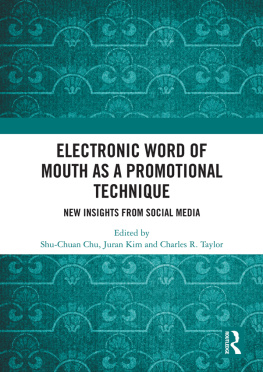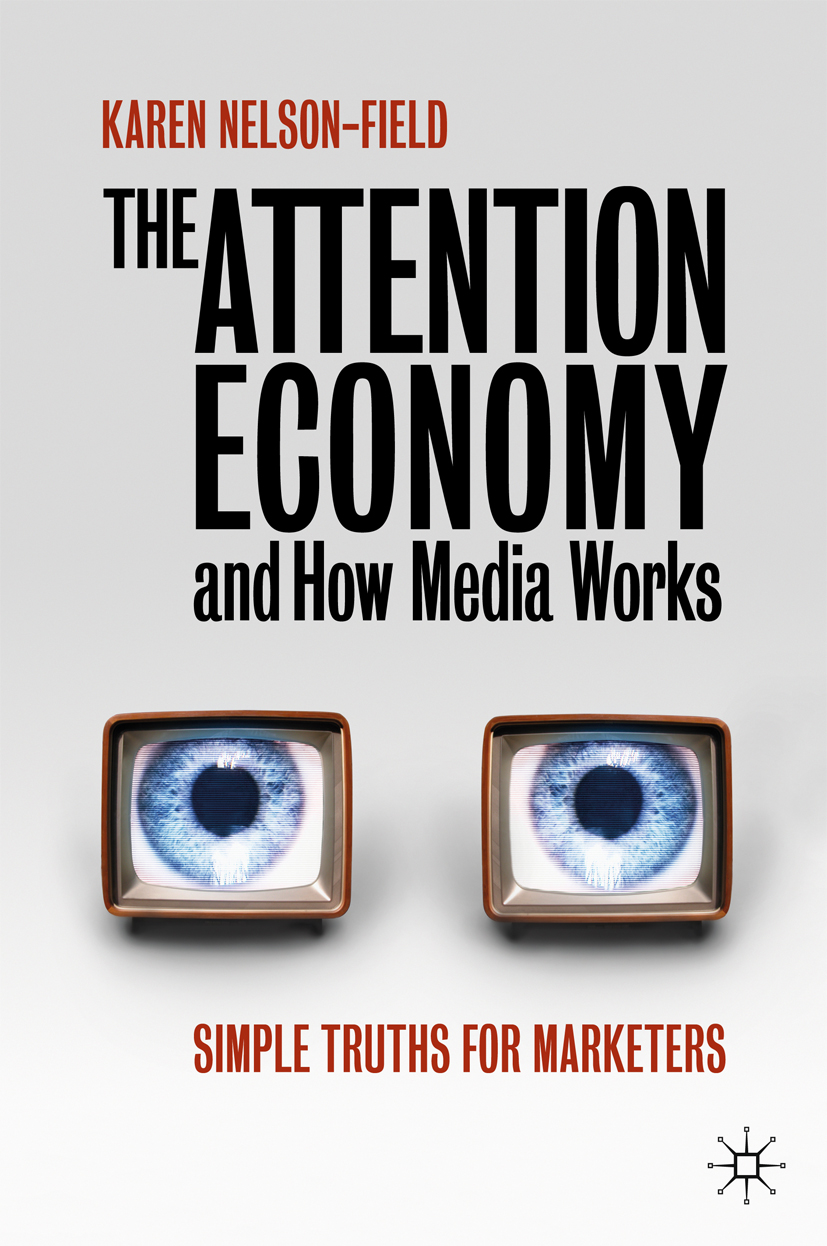Karen Nelson-Field
Amplified Intelligence Pty Ltd, Adelaide, SA, Australia
ISBN 978-981-15-1539-2 e-ISBN 978-981-15-1540-8
https://doi.org/10.1007/978-981-15-1540-8
The Editor(s) (if applicable) and The Author(s), under exclusive license to Springer Nature Singapore Pte Ltd. 2020
This work is subject to copyright. All rights are solely and exclusively licensed by the Publisher, whether the whole or part of the material is concerned, specifically the rights of translation, reprinting, reuse of illustrations, recitation, broadcasting, reproduction on microfilms or in any other physical way, and transmission or information storage and retrieval, electronic adaptation, computer software, or by similar or dissimilar methodology now known or hereafter developed.
The use of general descriptive names, registered names, trademarks, service marks, etc. in this publication does not imply, even in the absence of a specific statement, that such names are exempt from the relevant protective laws and regulations and therefore free for general use.
The publisher, the authors and the editors are safe to assume that the advice and information in this book are believed to be true and accurate at the date of publication. Neither the publisher nor the authors or the editors give a warranty, expressed or implied, with respect to the material contained herein or for any errors or omissions that may have been made. The publisher remains neutral with regard to jurisdictional claims in published maps and institutional affiliations.
Cover image: moodboard/Getty Images
This Palgrave Macmillan imprint is published by the registered company Springer Nature Singapore Pte Ltd.
The registered company address is: 152 Beach Road, #21-01/04 Gateway East, Singapore 189721, Singapore
Foreword
Todays world has gotten a lot noisier. Marketing messages are not only competing with other advertising, but also the latest adorable pet video, celebrity tweet, and break the internet moment of the day. With competition at an all-time high for peoples attention, marketing professionals are faced with a challenge thats impossible to ignore: how do we evolve our decision making in todays data-rich world to cut through all of the noise?
To get to the root of understanding human behaviour and what drives our impulses, my team at Mars shares Karens belief that we need a scientific approach to critically navigate the data-rich, attention-poor media environment. Our unique approach to behavioural advertising research is equally championed by the academic world and by the practitioners world, and we salute Karens long standing, robust contributions to unpacking this complex subject.
In this book, Karen tackles the rapidly changing media environment, creating a healthy debate on what it takes for businesses to win in the new attention economy. In a world where misinformation often spreads fastest and loudest, Karens voice is an important one. Its the voice of discovering our true north, through objective theory thats fundamentally grounded in scientific, behavioural measurement and sound methodology. Karen brings a unique perspective to examining these challenges from both a data-driven and human-centric perspective. Her work provides evidence-based answers to the media questions businesses are faced with daily, distilling them down into simple truths regarding the impact of rapidly evolving technology and the new challenges this creates for advertisers as we look to the future.
Karens writing is a great opportunity to tune out the noise and tune in to valuable insights on marketing. It deserves all your attention.
Laurent Larguinat Senior Director, Mars Consumer and Market Insights
Brussels, Belgium
Acknowledgements
For My Team
This book is certainly not a lone effort, rather it was built on the shoulders of a very special group. Our worlds and expertise vary so drastically but our seemingly eclectic group is pure gold and produces brilliant work. When I think about how far we have come in such a short time, and the global recognition we are afforded, I am so proud. When I think about how much fun we have in the office, and many roll-on-floor laughing moments weve had along the way, I am equally proud. Fun is good. So thank you to Dylan Lundy, Melissa Banelis, Carole Lydon, Brandon Matthews, Miguel Martin, Daniel Lyas, Erica Riebe, Kellen Ewens and Pippi Nottage. And thank you to our extended team of contractors who support us.
For My Family
Boys, oops!I did it again. I promised I wouldnt lock myself in an office to write a book and not feed you for extended periods again, but it happened. Thank you Connor and Alec for being big enough now to cook your own two-minute noodles (and for being awesome kids regardless of not actually understanding what your Mum does for a living).
Pete, it is so nice to put you in a publication dedication knowing I wont regret it. Your husband skills are without a doubt of the highest calibre and it is thanks to these skills that I can be the complicated person that I am and write these complicated books.
Thank you family, much love to you.
Contents
List of Figures
Fig. 1.1 The NBD and the banana
Fig. 4.1 The early years 17041950
Fig. 4.2 The middle years 19501990
Fig. 4.3 The later years 19902007
Fig. 5.1 Nelson-Field and Ewens conceptual model of Advertising Attention Processing (WARC, 2019)
Fig. 5.2 Demonstration of attention switching on in-feed social formats
Fig. 5.3 Demonstration of attention switching on pre-roll social formats
Fig. 5.4 STAS by attention level
Fig. 6.1 Relationship between STAS and pixels, 2017 and 2019
Fig. 6.2 Relationship between attention and pixels, 2017 and 2019
Fig. 6.3 Coverage versus pixels
Fig. 6.4 Coverage and pixels relative to spatial clutter
Fig. 7.1 Example brand annotation
Fig. 7.2 Attention sales differential
Fig. 7.3 Attention sales differential with branding
Fig. 8.1 Targeting versus broad reach (Field and Binet, IPA, Thinkbox and Google, 2017)
Fig. 8.2 Is once really enough? Measuring the advertising response function (Taylor 2010)
List of Tables
Table 6.1 Proportion of views reaching standard on mobile (varying pixels)
Table 6.2 Proportion of views reaching standard on mobile (varying seconds)
Table 7.1 Arousal and valence emotions pairs
Table 7.2 Impact by test ad type (attention)
Table 8.1 Media size and loyalty (Double Jeopardy within online ecosystem)
Notes on Contributors
Stuart Bailey
is an industry leader with over 18 years experience across the UK and Australia. Over his career, he has worked in business management, digital, trading and at an executive level at leading global media agencies giving him a full spectrum perspective of the industry. He is a specialist at transforming digital offerings and cultures and accelerating clients digital capabilities. Currently, Stuart is Chief Digital Officer at PHD Australia where he is evolving the digital product, championing education, driving key clients digital acceleration as well as delivering thought leadership on key industry topics.









